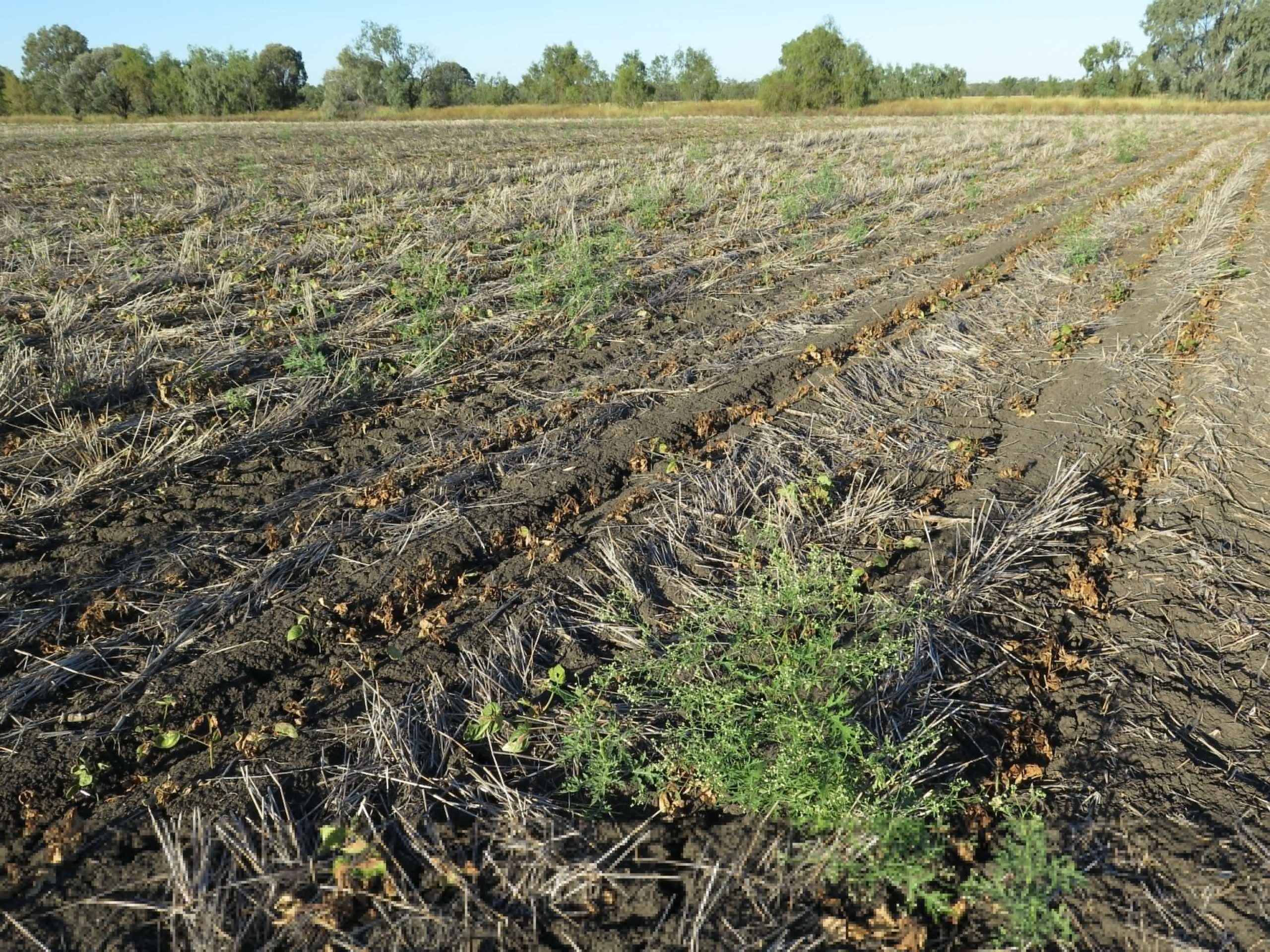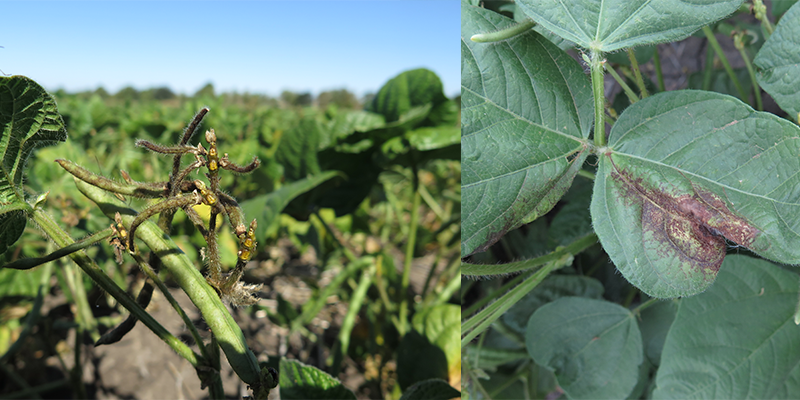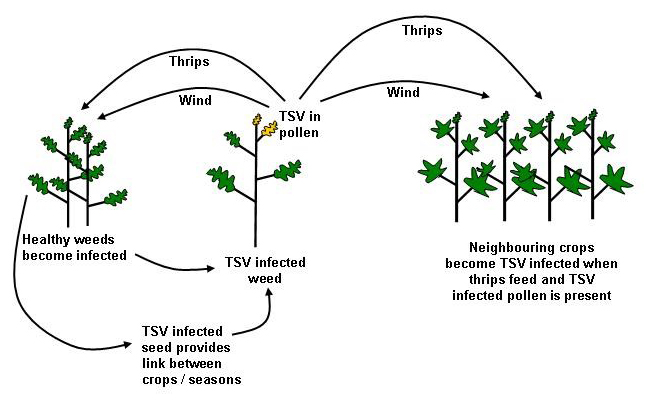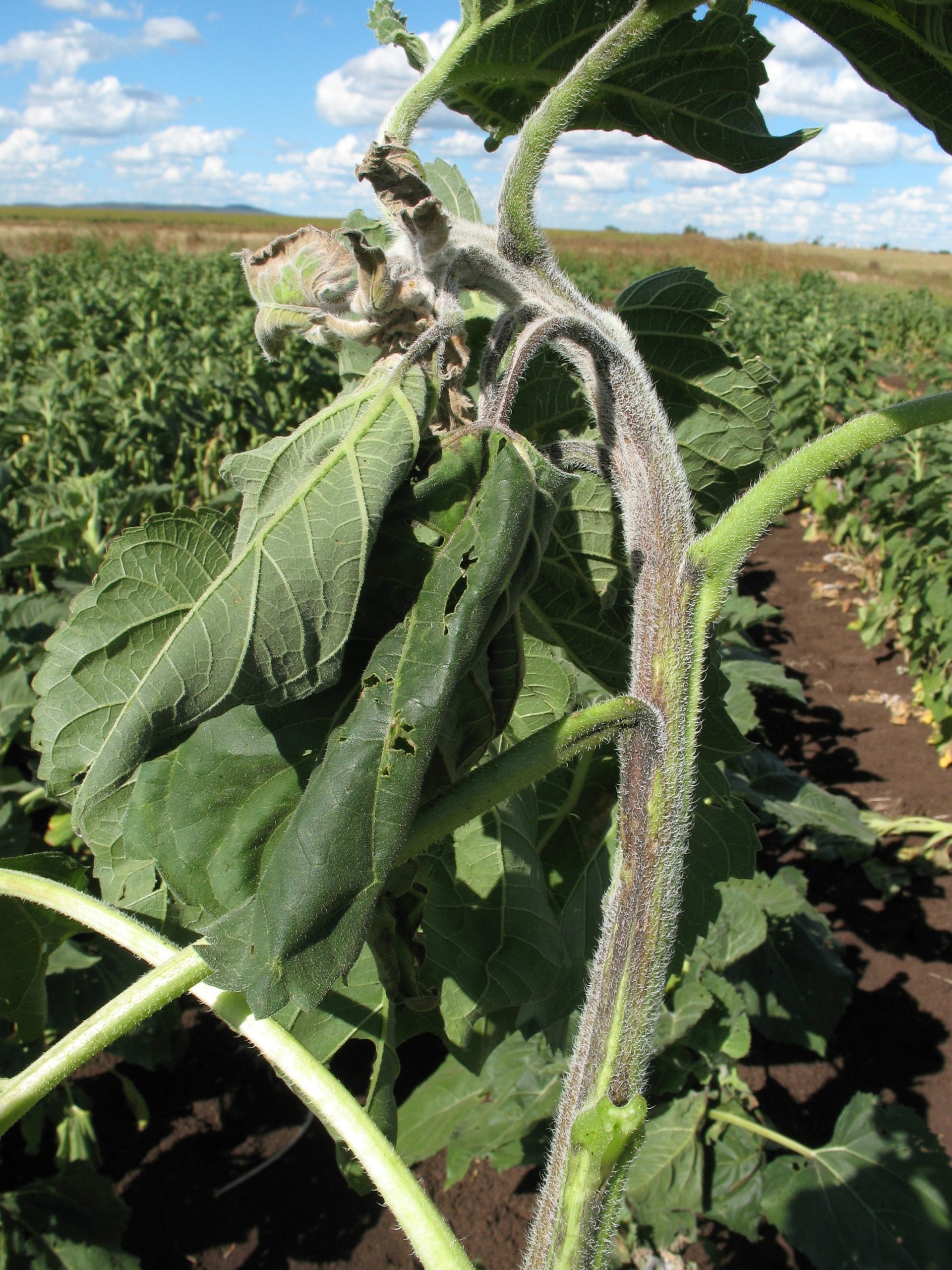Key points:
- There was a resurgence in tobacco streak virus (TSV) disease in mungbeans in early 2020
- TSV is restricted to central QLD and closely related to the distribution of parthenium weed
- Growers are encouraged to avoid areas of dense parthenium to reduce risk

Very severe TSV damage to young mungbeans, central QLD in April 2020. This paddock was surrounded by dense parthenium and some parthenium plants can also be seen within the paddock.
In autumn of 2020, tobacco streak virus (TSV) was found to be common in all mungbean crops inspected in the central highlands region of Central Queensland with crops having approximately 20-85% of plants infected. Many of the plants had severe disease symptoms including necrosis on the leaves, terminal growing points and pods. Severe outbreaks of TSV in mungbean were also reported from the Theodore region. Despite being present in central Queensland every season, TSV occurred at higher than normal incidence and severity last season in mungbean.

Necrotic and withered mungbean pods infected by TSV left) and TSV will often cause necrotic lesions on the leaves which can spread down into the stem right).
We know from previous research that there are two different species of TSV that affect susceptible crops, one is common in parthenium weed and is called parthenium-TSV, and the other is common in crownbeard or wild sunflower (crownbeard-TSV). Both of these weed hosts display no symptoms when infected. Historically, most severe disease TSV outbreaks are caused by parthenium-TSV. Sometimes pods can be severely affected by TSV. It is thought that thrips carrying TSV-infected parthenium pollen are attracted to the mungbean flowers and infect developing pods.
Parthenium is currently restricted to the central highlands region and as such, TSV is also restricted to this region but there is a risk it can move to new regions. There is also a risk that TSV disease can occur in locations where there are high densities of crownbeard which has a wider geographical range than parthenium.
Life cycle of TSV and worst times for infection
TSV can only survive in living plant hosts or in seed of some of those hosts (e.g. parthenium). It does not survive in soil or on dead plant material. TSV is only transmitted in pollen and seed of some hosts. It infects healthy plants via the feeding wounds of thrips which allows TSV-infected pollen to enter.

Disease Cycle of TSV
There are several thrips species that can vector TSV and all are commonly found feeding in flowers. The prolific flowering of parthenium and crownbeard make these ideal hosts for thrips which can then easily move infected pollen into nearby crops. TSV disease is favoured by climatic conditions which enable high thrips populations to develop, and large amounts of infective pollen to be produced by weed hosts such as parthenium and crownbeard. These conditions generally occur during warmer months and are highly dependent on rainfall and weed growth patterns.
The life cycle of thrips is shorter during summer months, which allows population numbers to rapidly increase. Thrips populations will generally increase as weed growth increases following intermittent rainfall, while prolonged periods of rain over many days often reduces thrips populations. The highest rates of virus transmission will occur when thrips numbers are high and there are large areas of a TSV-infected flowering virus host plant, such as parthenium. These conditions can result in high TSV disease rates in susceptible crops as large quantities of TSV-infected pollen is moved rapidly into crops by high numbers of thrips. Plants are most susceptible at the seedling stage.
Summers of intermittent rain following dry autumns (March – May) are most favourable for development of large populations of both parthenium and thrips which results in more TSV disease. These conditions were experienced in autumn of 2020 and the situation was made worse by the extremely dry conditions in Spring 2019 which lead to disturbed, bare ground that is favourable for prolific parthenium growth with summer rains. TSV is seed transmitted in parthenium so a proportion of parthenium that germinated in early 2020 would have been TSV-infected. By about March 2020, there was lots of TSV-infected pollen from large areas of parthenium or crownbeard, high thrips populations and young mungbean crops (the most susceptible crop stage). When the rains stopped, the weeds became less favourable for thrips which moved with TSV-infected pollen into crops and caused severe TSV disease epidemics in some locations.
Some hybrids of sunflower are also highly susceptible to TSV infection and display severe necrosis on leaves and stems, often resulting in plant death. Sunflower crops were not inspected in central Queensland in early 2020 but if susceptible hybrids were planted it is likely some crops would have been affected by TSV.

Some hybrids of sunflower are also highly susceptible to TSV infection leading to severe terminal and stem necrosis and often lodging or death. Other hybrids are highly tolerant with virtually no damage.
Dispersal
TSV-infected pollen can be dispersed significant distances by wind or thrips but generally crop damage is worse in close proximity to parthenium or crownbeard weed. TSV is seed transmitted in some alternative hosts such as parthenium, crownbeard, cobblers pegs and fleabane. In particular, TSV is seed transmitted in parthenium at high rates and remains viable for several years in ungerminated seed so that even after drought conditions, germinating parthenium is often TSV-infected (but not symptomatic). There is significant risk of long distance dispersal into new growing regions if infected parthenium or crownbeard seed is moved with machinery or harvested goods. Research indicates that TSV is not seed transmitted in mungbean or sunflower.
Control options
No useful tolerance to TSV has been identified in mungbean germplasm to date and as such cultural practices are the most effective control options available to minimise risk of TSV. Most importantly, avoid planting close to and downwind of areas of flowering parthenium or crownbeard when crops are young and most susceptible. Determine and where possible, avoid areas of high risk such as locations either with a history of TSV or next to areas with a high density of parthenium (e.g. neighbouring grazing paddocks). Planting upwind of high risk areas may help to reduce transmission of TSV into crops; higher rates of disease are commonly seen downwind of these high risk areas.
Maintain crop hygiene; particularly control of parthenium in or upwind of the crop both prior to planting and during the early stages of the crop. Spraying out areas of parthenium or slashing flowering parthenium prior to planting may also help to reduce the level of virus moving into crops.
It is unlikely that in-crop applications of insecticides for thrips control will provide effective control of TSV transmission into the crop and may disrupt effectiveness of integrated insect management systems. Field trial results of various seed treatments showed no significant difference to TSV transmission by thrips.
If growing sunflowers, the best control option is to select hybrids which have been shown to have good tolerance to TSV infection.
This research is supported through the Department of Agriculture and Fisheries and the Grains Research and Development Corporation (GRDC) project Surveys and associated diagnostics of the incidence and severity of diseases of cereal and pulses within the Northern Region (DAQ1907-001RTX).
